Abstract
The thesis is developed that an acceptable model of biological energy coupling must have universal application. The paired moving charge model of mitochondrial energy coupling is examined from the standpoint of this thesis. Fundamental to this model is the notion that energy coupling involves interaction between paired uncompensated charged species in two vectorially aligned and spatially separated reaction centers. The two charge-separating devices are assumed to be the electron transfer chain (in chloroplast and mitochondria) and intrinsic ionophores (in all transducing organelles and kinases). The universality of the ionophore principle becomes then the crucial test of the validity of the paired moving charge model. The multiple facets of ionophore-mediated couples processes are explored, e.g., coupled hydrolysis of ATP, hormonal control of ion movements, and active transport.
Full text
PDF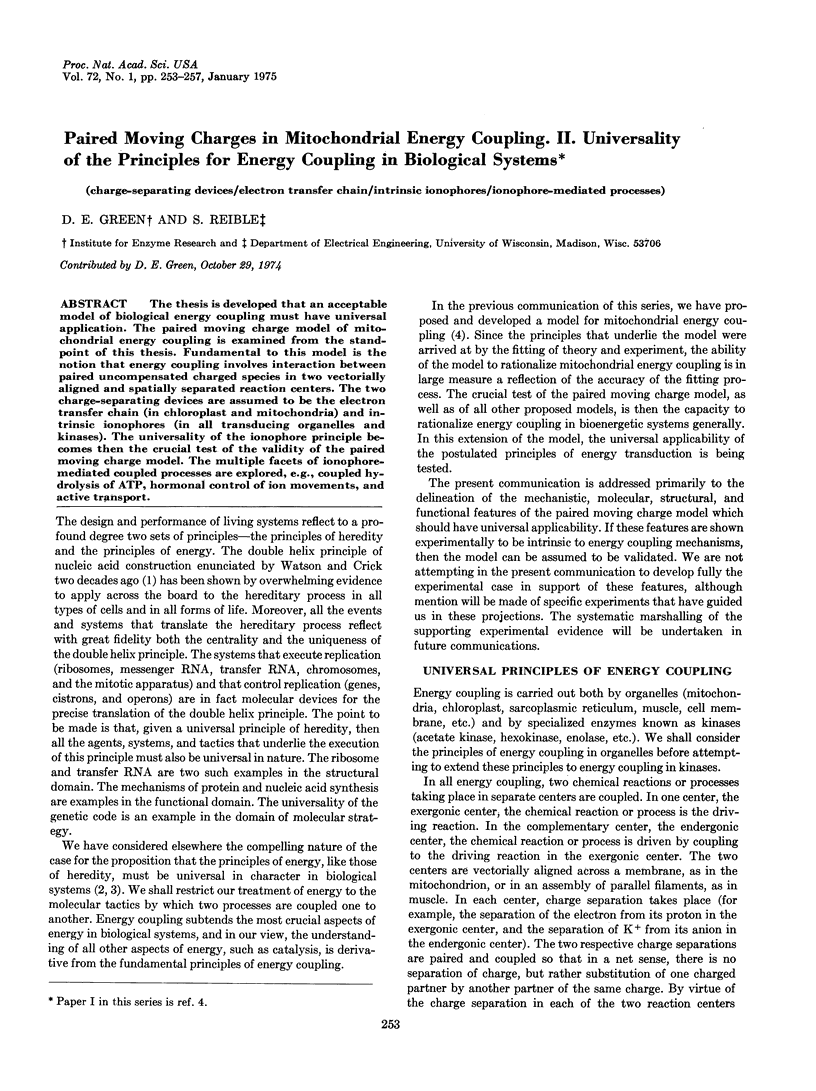
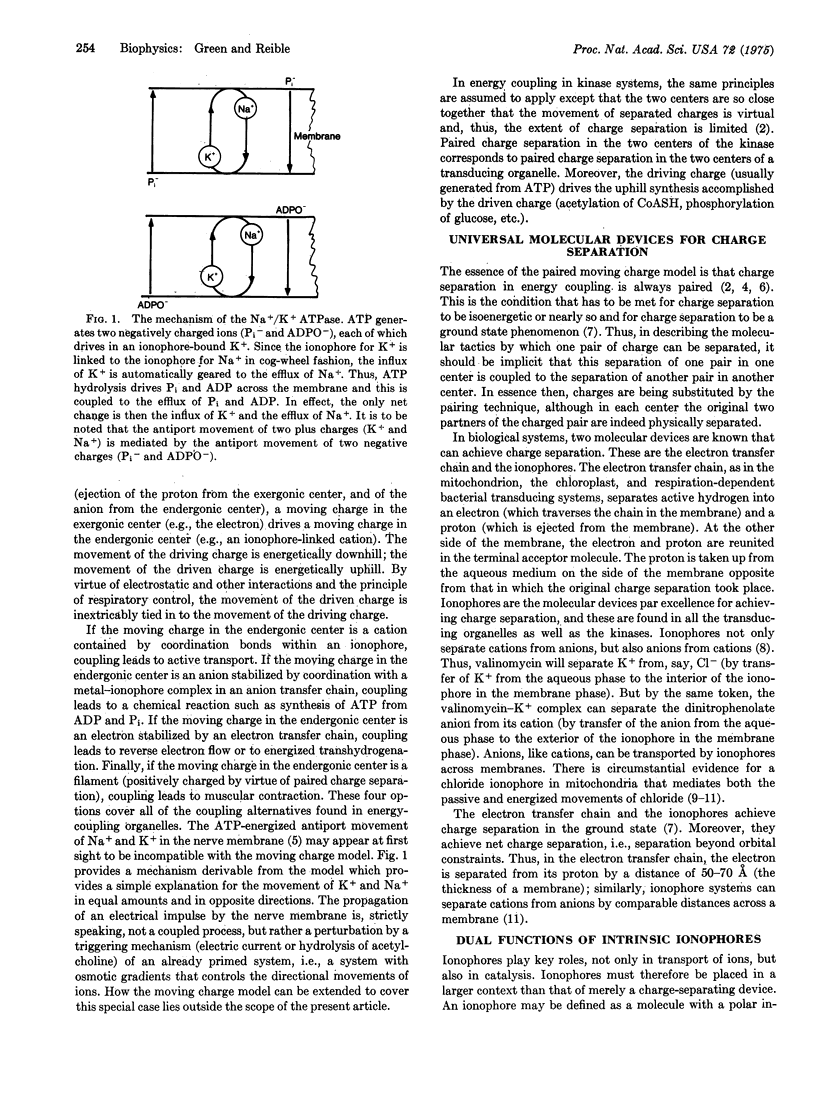
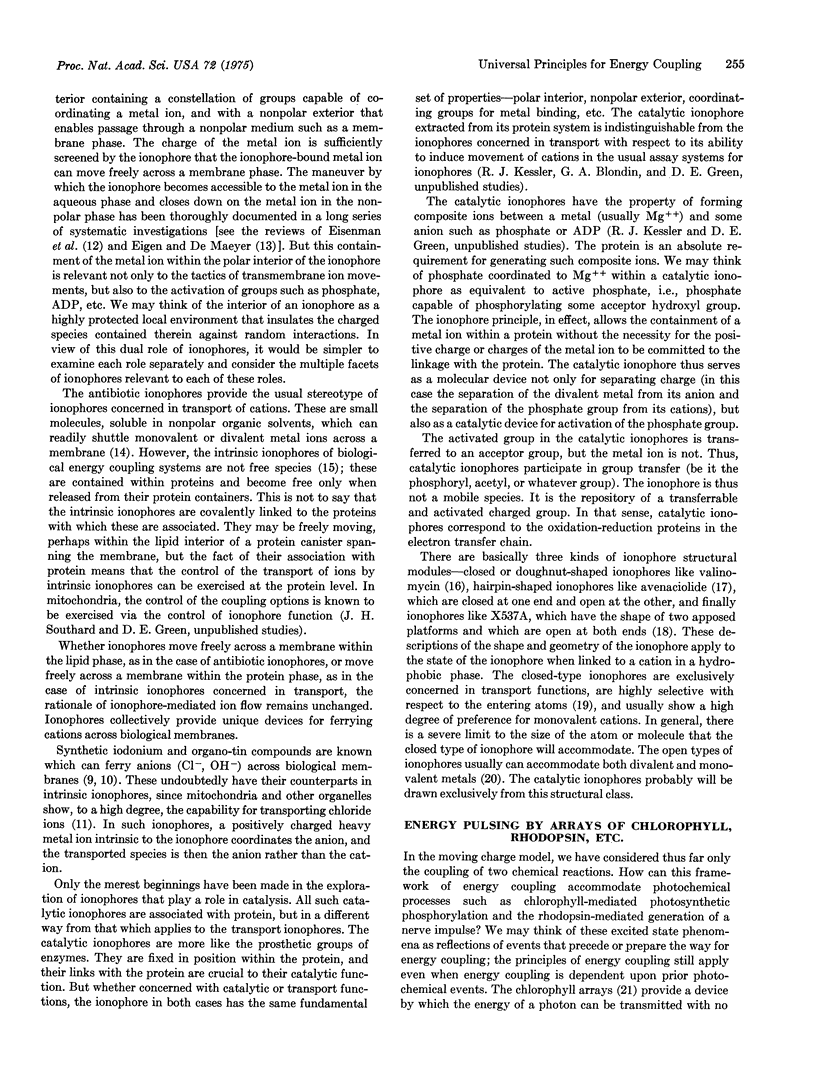
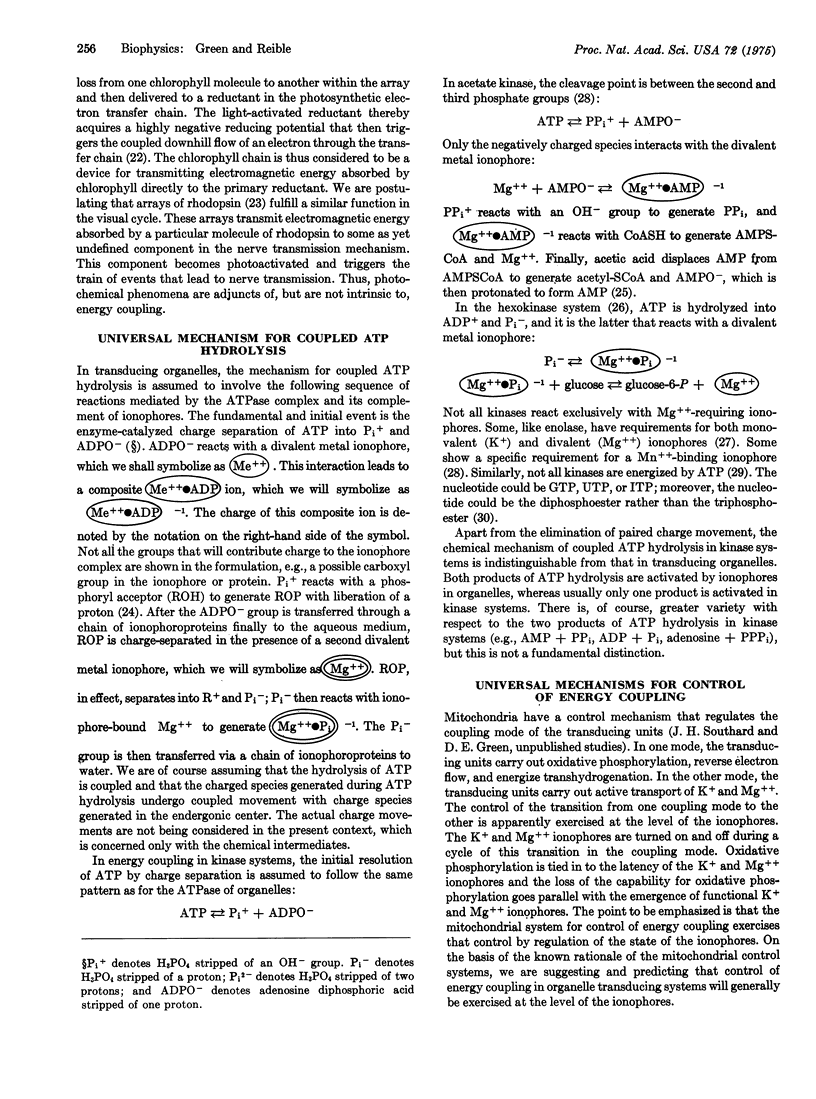
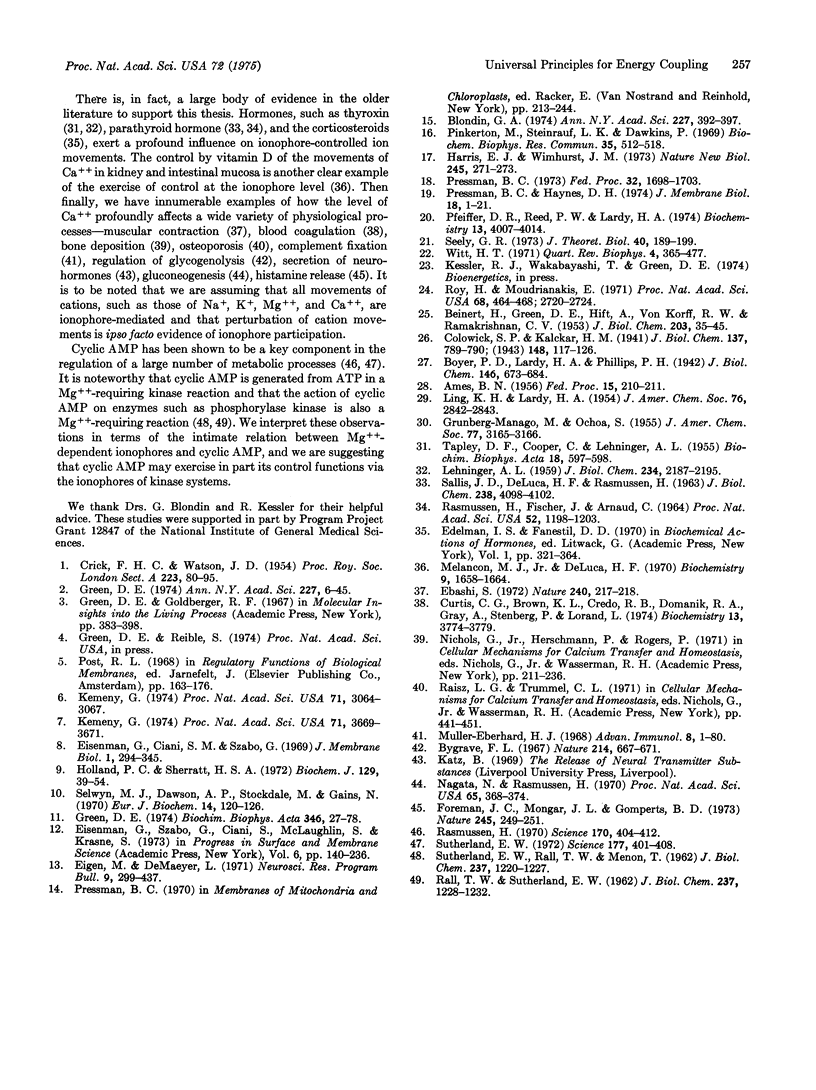
Selected References
These references are in PubMed. This may not be the complete list of references from this article.
- BEINERT H., GREEN D. E., HELE P., HIFT H., VON KORFF R. W., RAMAKRISHNAN C. V. The acetate activating enzyme system of heart muscle. J Biol Chem. 1953 Jul;203(1):35–45. [PubMed] [Google Scholar]
- Blondin G. A. Isolation of ionophores from mitochondria. Ann N Y Acad Sci. 1974 Feb 18;227:392–397. doi: 10.1111/j.1749-6632.1974.tb14402.x. [DOI] [PubMed] [Google Scholar]
- Bygrave F. L. The ionic environment and metabolic control. Nature. 1967 May 13;214(5089):667–671. doi: 10.1038/214667a0. [DOI] [PubMed] [Google Scholar]
- Curtis C. G., Brown K. L., Credo R. B., Domanik R. A., Gray A., Stenberg P., Lorand L. Calcium-dependent unmasking of active center cysteine during activation of fibrin stabilizing factor. Biochemistry. 1974 Aug 27;13(18):3774–3780. doi: 10.1021/bi00715a024. [DOI] [PubMed] [Google Scholar]
- Ebashi S. Calcium ions and muscle contraction. Nature. 1972 Nov 24;240(5378):217–218. doi: 10.1038/240217a0. [DOI] [PubMed] [Google Scholar]
- Foreman J. C., Mongar J. L., Gomperts B. D. Calcium ionophores and movement of calcium ions following the physiological stimulus to a secretory process. Nature. 1973 Oct 5;245(5423):249–251. doi: 10.1038/245249a0. [DOI] [PubMed] [Google Scholar]
- Green D. E. The electromechanochemical model for energy coupling in mitochondria. Biochim Biophys Acta. 1974 Apr 30;346(1):27–78. doi: 10.1016/0304-4173(74)90011-1. [DOI] [PubMed] [Google Scholar]
- Harris E. J., Wimhurst J. M. Is avenaciolide another ionophore? Nat New Biol. 1973 Oct 31;245(148):271–273. doi: 10.1038/newbio245271a0. [DOI] [PubMed] [Google Scholar]
- Haynes D. H., Pressman B. C. Two-phase partition studies of alkali cation complexation by ionophores. J Membr Biol. 1974;18(1):1–21. doi: 10.1007/BF01870099. [DOI] [PubMed] [Google Scholar]
- Holland P. C., Sherratt H. S. Biochemical effects of the hypoglycaemic compound diphenyleneiodonnium. Catalysis of anion-hydroxyl ion exchange across the inner membrane of rat liver mitochondria and effects on oxygen uptake. Biochem J. 1972 Aug;129(1):39–54. doi: 10.1042/bj1290039. [DOI] [PMC free article] [PubMed] [Google Scholar]
- Kemeny G. Charged pair current networks in bioenergetics. Proc Natl Acad Sci U S A. 1974 Aug;71(8):3064–3067. doi: 10.1073/pnas.71.8.3064. [DOI] [PMC free article] [PubMed] [Google Scholar]
- Kemeny G. Energy transfer mechanisms in mitochondria. Proc Natl Acad Sci U S A. 1974 Sep;71(9):3669–3671. doi: 10.1073/pnas.71.9.3669. [DOI] [PMC free article] [PubMed] [Google Scholar]
- LEHNINGER A. L. Reversal of thyroxine-induced swelling of rat liver mitochondria by adenosine triphosphate. J Biol Chem. 1959 Aug;234(8):2187–2195. [PubMed] [Google Scholar]
- Melancon M. J., Jr, DeLuca H. F. Vitamin D stimulation of calcium-dependent adenosine triphosphatase in chick intestinal brush borders. Biochemistry. 1970 Apr 14;9(8):1658–1664. doi: 10.1021/bi00810a002. [DOI] [PubMed] [Google Scholar]
- Müller-Eberhard H. J. Chemistry and reaction mechanisms of complement. Adv Immunol. 1968;8:1–80. doi: 10.1016/s0065-2776(08)60464-2. [DOI] [PubMed] [Google Scholar]
- Nagata N., Rasmussen H. Parathyroid hormone, 3'5' AMP, Ca++, and renal gluconeogenesis. Proc Natl Acad Sci U S A. 1970 Feb;65(2):368–374. doi: 10.1073/pnas.65.2.368. [DOI] [PMC free article] [PubMed] [Google Scholar]
- Pfeiffer D. R., Reed P. W., Lardy H. A. Ultraviolet and fluorescent spectral properties of the divalent cation ionophore A23187 and its metal ion complexes. Biochemistry. 1974 Sep 10;13(19):4007–4014. doi: 10.1021/bi00716a029. [DOI] [PubMed] [Google Scholar]
- Pinkerton M., Steinrauf L. K., Dawkins P. The molecular structure and some transport properties of valinomycin. Biochem Biophys Res Commun. 1969 May 22;35(4):512–518. doi: 10.1016/0006-291x(69)90376-3. [DOI] [PubMed] [Google Scholar]
- Pressman B. C. Properties of ionophores with broad range cation selectivity. Fed Proc. 1973 Jun;32(6):1698–1703. [PubMed] [Google Scholar]
- RALL T. W., SUTHERLAND E. W. Adenyl cyclase. II. The enzymatically catalyzed formation of adenosine 3',5'-phosphate and inorganic pyrophosphate from adenosine triphosphate. J Biol Chem. 1962 Apr;237:1228–1232. [PubMed] [Google Scholar]
- RASMUSSEN H., FISCHER J., ARNAUD C. PARATHYROID HORMONE, ION EXCHANGE, AND MITOCHONDRIAL SWELLING. Proc Natl Acad Sci U S A. 1964 Nov;52:1198–1203. doi: 10.1073/pnas.52.5.1198. [DOI] [PMC free article] [PubMed] [Google Scholar]
- Rasmussen H. Cell communication, calcium ion, and cyclic adenosine monophosphate. Science. 1970 Oct 23;170(3956):404–412. doi: 10.1126/science.170.3956.404. [DOI] [PubMed] [Google Scholar]
- Roy H., Moudrianakis E. N. Interactions between ADP and the coupling factor of photophosphorylation. Proc Natl Acad Sci U S A. 1971 Feb;68(2):464–468. doi: 10.1073/pnas.68.2.464. [DOI] [PMC free article] [PubMed] [Google Scholar]
- SALLIS J. D., DELUCA H. F., RASMUSSEN H. PARATHYROID HORMONE-DEPENDENT UPTAKE OF INORGANIC PHOSPHATE BY MITOCHONDRIA. J Biol Chem. 1963 Dec;238:4098–4102. [PubMed] [Google Scholar]
- SUTHERLAND E. W., RALL T. W., MENON T. Adenyl cylase. I. Distribution, preparation, and properties. J Biol Chem. 1962 Apr;237:1220–1227. [PubMed] [Google Scholar]
- Seely G. R. Energy transfer in a model of the photosynthetic unit of green plants. J Theor Biol. 1973 Jul;40(1):189–199. doi: 10.1016/0022-5193(73)90171-9. [DOI] [PubMed] [Google Scholar]
- Selwyn M. J., Dawson A. P., Stockdale M., Gains N. Chloride-hydroxide exchange across mitochondrial, erythrocyte and artificial lipid membranes mediated by trialkyl- and triphenyltin compounds. Eur J Biochem. 1970 May 1;14(1):120–126. doi: 10.1111/j.1432-1033.1970.tb00268.x. [DOI] [PubMed] [Google Scholar]
- Sutherland E. W. Studies on the mechanism of hormone action. Science. 1972 Aug 4;177(4047):401–408. doi: 10.1126/science.177.4047.401. [DOI] [PubMed] [Google Scholar]
- TAPLEY D. F., COOPER C., LEHNINGER A. L. The action of thyroxine on mitochondria and oxidative phosphorylation. Biochim Biophys Acta. 1955 Dec;18(4):597–598. doi: 10.1016/0006-3002(55)90171-2. [DOI] [PubMed] [Google Scholar]
- Witt H. T. Coupling of quanta, electrons, fields, ions and phosphrylation in the functional membrane of photosynthesis. Results by pulse spectroscopic methods. Q Rev Biophys. 1971 Nov;4(4):365–477. doi: 10.1017/s0033583500000834. [DOI] [PubMed] [Google Scholar]


